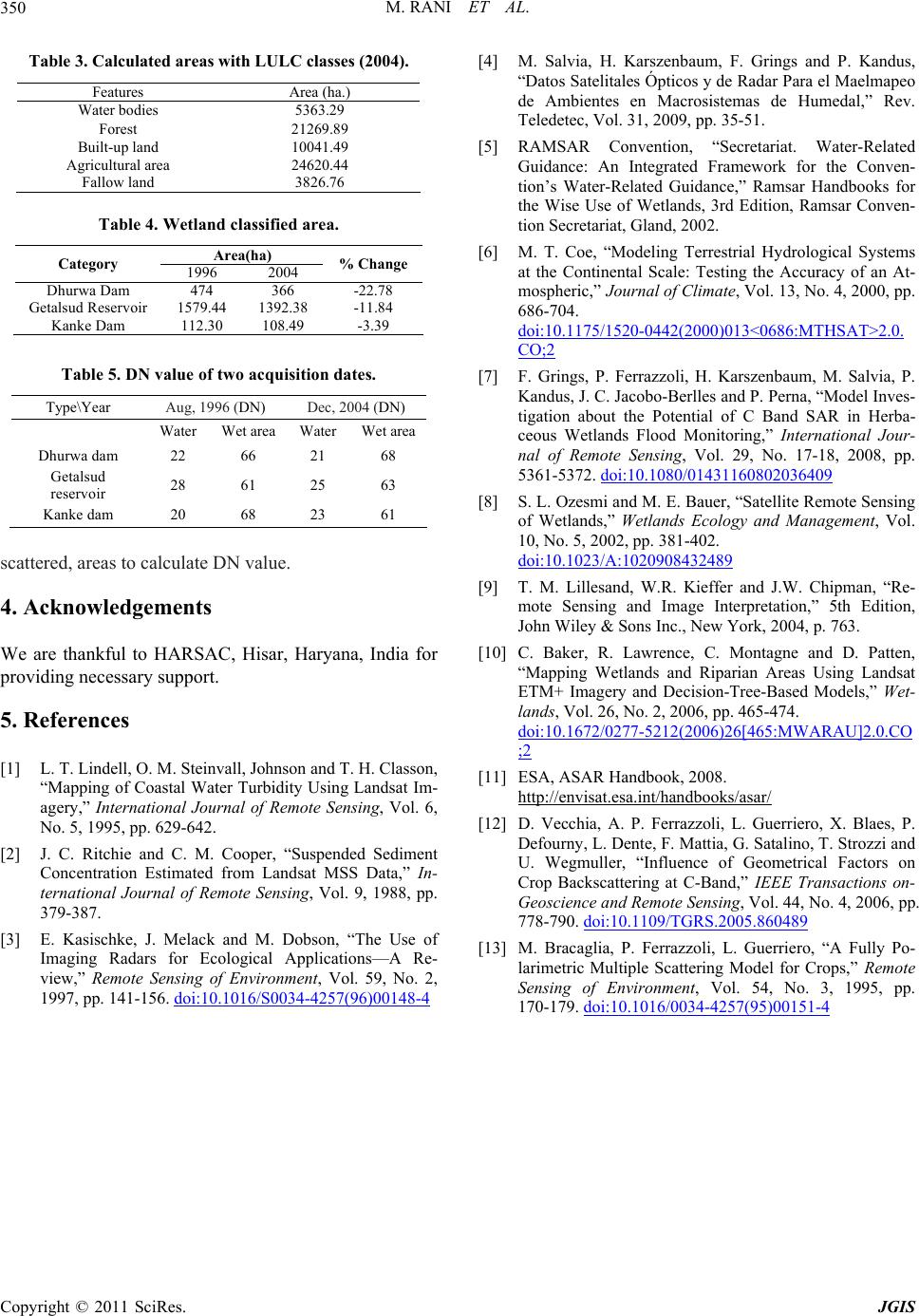
M. RANI ET AL.
Copyright © 2011 SciRes. JGIS
350
Table 3. Calculated areas with LULC classes (2004).
Features Area (ha.)
Water bodies 5363.29
Forest 21269.89
Built-up land 10041.49
Agricultural are a 24620.44
Fallow land 3826.76
Table 4. Wetland cla ssified area .
Area(ha)
Category 1996 2004
% Change
Dhurwa Dam 474 366 -22.78
Getalsud Reservoir 1579.44 1392.38 -11.84
Kanke Dam 112.30 108.49 -3.39
Table 5. DN value of two acquisition dates.
Type\Year Aug, 1996 (DN) Dec, 2004 (DN)
Water Wet area Water Wet area
Dhurwa dam 22 66 21 68
Getalsud
reservoir 28 61 25 63
Kanke dam 20 68 23 61
scattered, areas to calculate DN value.
4. Acknowledgements
We are thankful to HARSAC, Hisar, Haryana, India for
providing nece ssary s upp ort.
5. References
[1] L. T. Lindell, O. M. Steinvall, Johnson and T. H. Classon,
“Mapping of Coastal Water Turbidity Using Landsat Im-
agery,” International Journal of Remote Sensing, Vol. 6,
No. 5, 1995, pp. 629-642.
[2] J. C. Ritchie and C. M. Cooper, “Suspended Sediment
Concentration Estimated from Landsat MSS Data,” In-
ternational Journal of Remote Sensing, Vol. 9, 1988, pp.
379-387.
[3] E. Kasischke, J. Melack and M. Dobson, “The Use of
Imaging Radars for Ecological Applications—A Re-
view,” Remote Sensing of Environment, Vol. 59, No. 2,
1997, pp. 141-156. doi:10.1016/S0034-4257(96)00148-4
[4] M. Salvia, H. Karszenbaum, F. Grings and P. Kandus,
“Datos Satelitales Ópticos y de Radar Para el Maelmapeo
de Ambientes en Macrosistemas de Humedal,” Rev.
Teledetec, Vol. 31, 2009, pp. 35-51.
[5] RAMSAR Convention, “Secretariat. Water-Related
Guidance: An Integrated Framework for the Conven-
tion’s Water-Related Guidance,” Ramsar Handbooks for
the Wise Use of Wetlands, 3rd Edition, Ramsar Conven-
tion Secretariat, Gland, 2002.
[6] M. T. Coe, “Modeling Terrestrial Hydrological Systems
at the Continental Scale: Testing the Accuracy of an At-
mospheric,” Journal of Climate, Vol. 13, No. 4, 2000, pp.
686-704.
doi:10.1175/1520-0442(2000)013<0686:MTHSAT>2.0.
CO;2
[7] F. Grings, P. Ferrazzoli, H. Karszenbaum, M. Salvia, P.
Kandus, J. C. Jacobo-Berlles and P. Perna, “Model Inves-
tigation about the Potential of C Band SAR in Herba-
ceous Wetlands Flood Monitoring,” International Jour-
nal of Remote Sensing, Vol. 29, No. 17-18, 2008, pp.
5361-5372. doi:10.1080/01431160802036409
[8] S. L. Ozesmi and M. E. Bauer, “Satellite Remote Sensing
of Wetlands,” Wetlands Ecology and Management, Vol.
10, No. 5, 2002, pp. 381-402.
doi:10.1023/A:1020908432489
[9] T. M. Lillesand, W.R. Kieffer and J.W. Chipman, “Re-
mote Sensing and Image Interpretation,” 5th Edition,
John Wiley & Sons Inc., New York, 2004, p. 763.
[10] C. Baker, R. Lawrence, C. Montagne and D. Patten,
“Mapping Wetlands and Riparian Areas Using Landsat
ETM+ Imagery and Decision-Tree-Based Models,” Wet-
lands, Vol. 26, No. 2, 2006, pp. 465-474.
doi:10.1672/0277-5212(2006)26[465:MWARAU]2.0.CO
;2
[11] ESA, ASAR Handbook, 2008.
http://envisat.esa.int/handbooks/asar/
[12] D. Vecchia, A. P. Ferrazzoli, L. Guerriero, X. Blaes, P.
Defourny , L. Dent e, F. Matt ia, G. Sata li no, T. Stro zzi a nd
U. Wegmuller, “Influence of Geometrical Factors on
Crop Backscattering at C-Band,” IEEE Transactions on-
Geoscience and Remote Sensing, Vol. 44, No. 4, 2006, pp.
778-790. doi:10.1109/TGRS.2005.860489
[13] M. Bracaglia, P. Ferrazzoli, L. Guerriero, “A Fully Po-
larimetric Multiple Scattering Model for Crops,” Remote
Sensing of Environment, Vol. 54, No. 3, 1995, pp.
170-179. doi:10.1016/0034-4257(95)00151-4